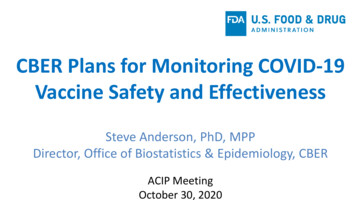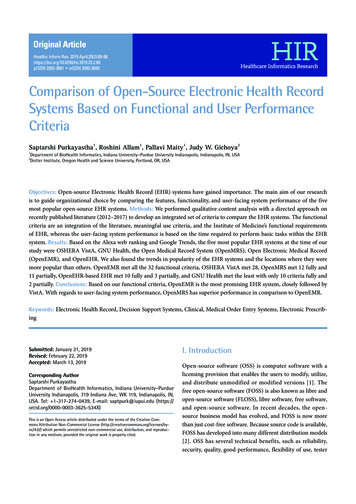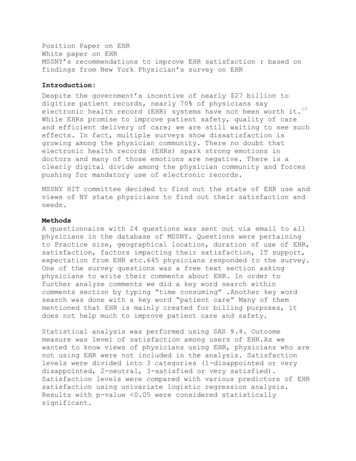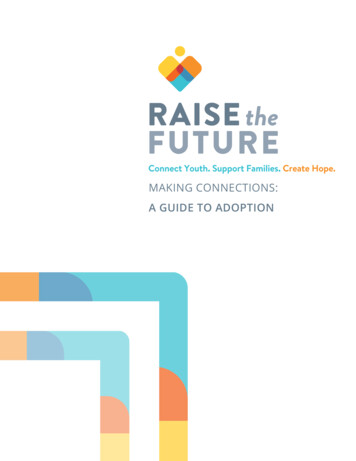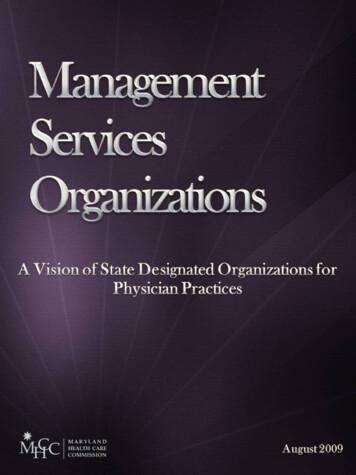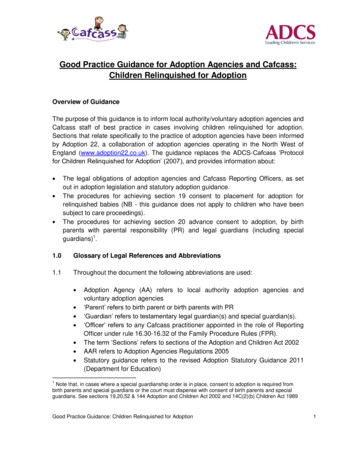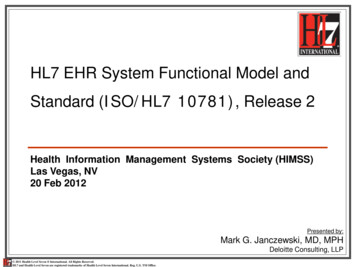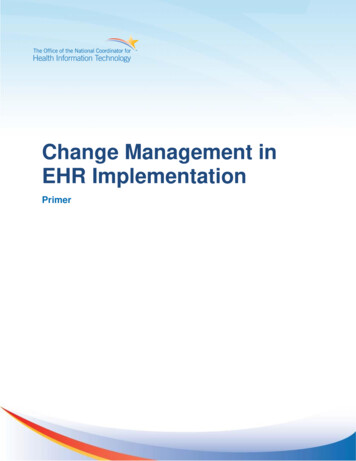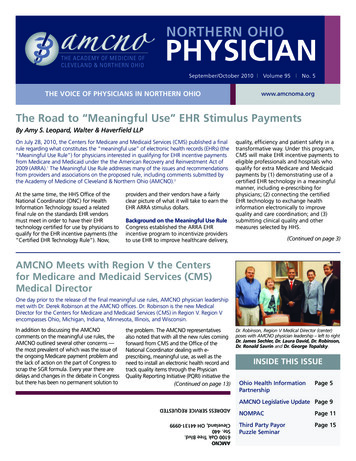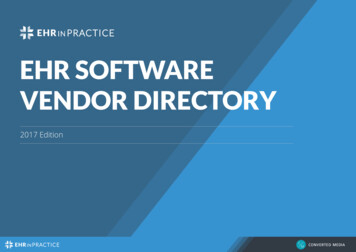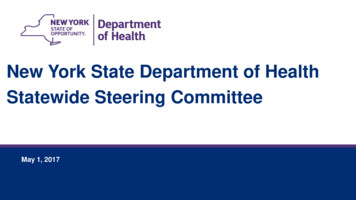
Transcription
Proceedings of the 50th Hawaii International Conference on System Sciences 2017Sorting out EHR adoption and assimilation in the Meaningful Useincentive program in HawaiiKelly HoldenUniversity of Hawai’i at Manoakholden@hawaii.eduElizabeth DavidsonUniversity of Hawai’i at Manoaedavidso@hawaii.eduAbstractbenefits of EMR benefits, this innovation was stilllargely restricted to large healthcare organizations; fewsmall practices or clinics where most Americansreceive their primary health care had access to thesesystems [35]. This disconnect was attributed to“cultural barriers and chronic market failures” [35].Although many barriers to widespread adoption ofEHRs were identified, financial barriers, notably thehigh cost to buy and implement an EHR and the lack ofincentives for health care providers to make thisinvestment, could be addressed via federal governmentpolicy and funding [3]. Lack of qualified health ITsupport services to help physicians implement EHRswas also identified as a target for U.S. federal policiesand funding [4].Because the U.S. federal government is the largestsingle payer in the healthcare system, and becausewidespread EHR use was viewed as a crucial tool toimprove individual and population health management,transparency and efficiency of care and the ability tostudy care delivery systems, the U.S. governmentundertook a large-scale program to stimulate EHRadoption and use [4]. As part of the The AmericanRecovery and Reinvestment Act of 2009, the HeathInformation Technology for Economic and ClinicalHealth Act (HITECH) established programs under theCenters for Medicare and Medicaid (CMS) to stimulatewidespread adoption and use of EHRs. In particular,the “Meaningful Use” program (MU) providedincentive payments for doctors who adopted a certifiedEHR technology and used it in ways specified by thisprogram [14]. The MU program made available up to 27 billion dollars nationwide to clinicians over a tenyear period through incentive payments. Each cliniciancould earn as much as 44,000 by applying through thefederal Medicare program, or 63,750 by applyingthrough state-run Medicaid programs [5]. The programwas aimed not only to stimulate purchase of an EHR,but to require physicians use the program inincreasingly robust ways: Stage 1 was to stimulateinitial digitization of health records; Stage 2 builds ondigitization to include quality measurement, clinicaldecision support, and information exchange; and StageBoth widespread adoption and meaningfulassimilation are needed to achieve the full benefits ofEHRs. In the U.S. the HITECH Act and its MeaningfulUse (MU) program have stimulated EHR adoption tohistorically high levels. Questions remain ces. In this paper, we report our analysis ofMeaningful Use attestation data for the period 20112014 in the State of Hawai’i. Findings indicate thatthe MU program primarily stimulated deeperassimilation of EHRs among existing adopters in 2011,mostly in large practice groups. In subsequent years,EHR adoption and assimilation, evidenced by MUattestation, increased then peaked among small,independent practices. In the final study year,attestation rates dropped for small practices, althoughonly one third of eligible providers have attested, whileattestation among larger practices remained steady asthis group shifted to the next MU stage. Findingssuggest small practices, particularly primary care andrural practices, continue to face high barriers tomeaningful EHR adoption and assimilation. Findingssuggest better targeted policies and incentives may beneeded to keep this promising program on track.1. IntroductionIn the United States and elsewhere, the use ofhealth information technology to promote healthsystem improvements has become a topic of muchinterest and concern. Policymakers have developedprograms aimed at the health care sector to promoteHIT adoption, particularly the use of electronic healthrecords (EHRs). In the U.S., adoption of EHRs was toolow according to health information technologies(HIT) researchers, advocates and professionals [2],[16], [31], [32]. In 2010, Dr. David Blumenthal, thehead of the Office of the National Coordinator forHealth IT (ONC) commented that despite years ofprofessional and bipartisan consensus about theURI: http://hdl.handle.net/10125/41572ISBN: 978-0-9981331-0-2CC-BY-NC-ND3421
3 is aimed at improving health outcomes for bothpatients and populations [14].The MU program of HITECH can be understood aspromoting related facets of innovation diffusion:technology adoption and assimilation [18, 19]. First,MU incentives require physicians to adopt EHRs bypurchasing (or otherwise acquiring) a system. Second,the MU program specifies specific (and increasing)ways a physician must use the EHR to qualify forincentives, requiring the physician to assimilate useinto his or her daily practices. Widespread adoptionacross practices and meaningful assimilation withinpractices together supports the goals of building apervasive health IT infrastructure in the U.S. healthcaresystem [3] [14] [19]. To qualify for incentivepayments, physicians are required to “attest” that theyare using a certified EHR and are meeting the MUcriteria for use through an Internet interface with CMS.For instance, Stage 1 criteria include using electronicprescribing, maintaining problem lists for patients, andusing certain clinical decision support tools in acertified EHR system. Thus “MU attestation” numbersprovide an indicator of the extent of adoption andassimilation of EHRs into U.S. physician practices.Six years since its initiation, many questions remainabout the effectiveness of the MU program forachieving stated goals. As part of its open governancepolicy, the ONC publishes detailed reports on thestatus of the program to address some questions.Importantly, the ONC also publishes detailed data onphysician attestation by state [6]. These data sets allowresearchers and policy analysts to delve more deeplyinto program results to fully investigate theoretical andpolicy issues. In this paper, we report the results ofsuch an investigation into the MU program forclinicians in the State of Hawai’i during the years2011-2014. We chose the State of Hawai’i because ofour in-depth knowledge of this healthcare market,which allowed us to enhance the value of ONCsupplied data with additional data (such as physicianpractice type, urban vs. rural practice) and to interpretaggregate numbers in light of state-level marketcharacteristics. Complete ONC data was available for2011-2014 at the time of our study.In the following sections we briefly review theliterature on the MU program as well as theoreticalinsights about organizational IT adoption such asEHRs. We then outline our research methods andpresent findings on EHR attestation in Hawai’i. Ouranalysis highlights progress with EHR adoption andassimilation as well issues and concerns about futuretrends. The data are specific to the State of Hawai’i,but our literature review suggests these issues arerepresentative of broad policy concerns.2. The Meaningful Use Program to-dateThe MU program represents a multi-level effortlead by CMS to stimulate adoption of EHRs to directuse in medical practice towards clinically usefulpractices that would improve outcomes. MU also aimsto build the national HIT infrastructure that wouldallow health data sharing across clinicians. Therefore,there are several components to achieving MU: (i)increased adoption, (ii) assimilation into practice inclinically relevant ways (not just practicemanagement), and (iii) national-level and communitylevel assimilation that builds the HIT infrastructure. Inorder to achieve this, MU incentive payments arespecifically tied both to initial adoption andassimilation of EHRs by physicians in private practicesand in hospital settings [5, 22]. Widespread use isimportant to improve quality, safety and efficiencywithin practices and across healthcare settings [9].Since its inception in 2009, and initiation ofincentive payments in 2011, the ONC monitorsprogress through MU attestation by physicians for agiven stage of the program (1, 2 or 3), as well as bysurveysconductedamongphysiciansandcommissioned evaluation reports. Official, aggregatestatistics suggest the program has been successful onseveral important fronts. For instance, in 2015 theONC reported that 95% of all eligible and criticalaccess hospitals had demonstrated meaningful use ofcertified health IT systems, with some states with largerural areas (e.g., Alaska, Hawai’i, Texas) laggingslightly.1 In contrast, 56% of office-based physicianshad demonstrated meaningful use, with only a fewstates having higher rates.2 This last statistic isimportant, as much healthcare in the US is delivered byoffice-based physicians in small practices. (Our studyfocuses on these practices, as we discuss shortly.)As the meaningful use program continues, thechallenge for policymakers and physicians alike will beto ensure that MU actually results in meaningfulbenefits and outcomes [9]. Studies of the MU programthus far suggest a more difficult task than aggregateattestation numbers alone would indicate. Early reportsare beginning to appear in the literature, e.g., [13] [21][22] [26] [29] [33] [37] [38] [39]. Here, we highlightkey findings and observations.First, professional groups, such as the AmericanMedical Association (AMA) have critiqued the contentand schedule of the MU program, as have re-Professionals-EHR-Incentive-Programs.php3422
technology vendors who must enhance their softwareand undergo certification to meet the MU criteria. As aresult, the timeline for MU stages has been extendedand certain criteria have been dropped or modified(such as ensuring electronic data exchange withpatients.). Delays are due in part to the initial highlyaggressive timeline set forth by policymakers toimplement MU within the 10-year timeframe andissues in the technology market with vendors.Organizations such as the AMA have criticizedrequirements that they suggest could “lead to thecommodification of heretofore ‘professional’ skills asindustrial models increase pressure to broaden thescope of practice for non- or paraprofessionals” [35].The latest delay, announced June 2016, “intends toextend the timeline for Stage 2 and delay Stage 3meaningful use attestation. The new timeline wouldextend Stage 2 meaningful use through 2016. Stage 3would begin in 2017 for providers who have completedat least two years in Stage 2.” [15]. Despite theprogress suggested by ONC attestation numbers, thesedelays indicate significant implementation issues.Resistance is due in part to what some researcherslabel misaligned incentives in the health care marketsbetween “those who pay (insurers), those whorecommend treatment (providers), and those whoexperience treatment (patients).” [35]. While insurersand patients may see value in a physician using anEHR, providers may find that incentive payments donot compensate them adequately for the additional timespent documenting their work and ongoing costs of theEHR [13]. “If nothing else, this explains why verticallyintegrated providers (merging as they do the insuranceand care functions) appear disproportionately on listsof those who have successfully implementedcomprehensive EMRs.” [35].An ancillary impact that researchers have identifiedis stifled innovation. The Office of the NationalCoordinator for Health Information Technology (ONC)aims to encourage innovation and create “anenvironment of testing, learning, and improving,thereby fostering breakthroughs that quickly andradically transform health care” [39]. Policymakersmay have underestimated the impact meeting MUprogram requirements would have on organizations.Although HITECH provides some incentives andimplementation support resources, many organizationsface the ongoing issue of diverting time and attentionto simply meeting basic MU requirements, divertingattention from finding solutions to other local andnational health care reform priorities [23] [33].The national level MU program is intended topromote both widespread adoption of EHRs across thevarious healthcare settings (ambulatory and in-hospital,small and large groups, rural and urban, etc.) and toensure assimilation of a minimal set of EHR usepractices (the MU criteria) [3], [4], [5]. However,healthcare settings vary greatly in organizationalcharacteristics and thus in their ability to assimilatecomplex organizational technologies such as EHRs(e.g. [37], [38]). Studies have shown that there aredisparities in adoption of EHRs among ambulatorycare providers due to multiple factors that are notaddressed by the current MU policies and incentives. A2016 meta-analysis of MU studies [37] identified thefollowing factors influencing rates of adoption andattestation: urban versus rural location, practice size,and patient population factors such as payer mix andrace/ ethnicity. One conclusion rom the meta-analysisis that a “one size fits all” EHR incentive programcannot address the complexities and disparities acrossthe U.S. healthcare system. [37] This conclusion isshared by other researchers (e.g. [5], [38]) in this areawho agree that MU and HITECH “must be calibratedto reflect both the capacities of the providers who facea multitude of real-world challenges and the maturityof the technology itself.” [5]3. EHR adoption and assimilation theoryIT assimilation research suggests such findings arenot surprising. Research has shown that adoption ofany IT innovation is impacted by an organization’sability to acquire and implement the innovation intothe organization [18], [19]. Moreover, barriers differfor different sizes and types of organizations. Forinstance, larger organizations are generally more robustadopters of innovations, as they have the capacity tolearn about and integrate new technologies. Plus, theyhave a greater potential to benefit from the innovationacross the enterprise [18]. This is evident in healthcaresettings as well, as large organizations such ashospitals have resources to dedicate to IT innovationprojects, whereas small healthcare organizations do not[10]. Of note, prior to the MU program, many surveysand research reports illustrated that practice size wasconsistently associated with EHR adoption, in thatsmall practices were consistently the least likely tohave adopted an EHR system [31] [32].In healthcare settings practice size, and secondarilypractice location, are generally associated withorganizational resources needed to assimilate ITinnovations. (Rural healthcare settings tend to be small,understaffed, and remote from market resources suchas consultants.) In general, small practice physiciansare independent providers who may work with 1-5physician partners in a practice they own, and supportstaff (nurses, lab techs, administrative staff) is usuallyminimal. Large physician practices are traditionally3423
associated with larger health systems and are alignedwith hospitals and medical centers. These practicestypically have highly integrated information systems,and support staff for administrative, diagnostic andclerical needs.Though EHR adoption and assimilation is costlyfor all organizations, larger organizations have greaterstaff resources [11] than small practices to do so. Infact, the physicians/owners may be the only resourceswho can decide what software package to purchase,manage the implementation project, and design theworkflow changes for his or her office [12]. Front-lineproviders (physicians, nurses, specialists, lab, imagingand other technical staff), clerical staff and operationsstaff must understand the EHR and utilize itappropriately [17]. Challenges to doing so include lackof EHR knowledge, workflow disruptions, and lack ofinteroperability” [39], requiring resources, such as ITspecialists, workflow analysts, and trainers [10].Having long lagged in EHR adoption, smallindependent (community) practices may continue tolag with meaningful use attestation as they strugglewith assimilation, or they may choose not to adopt andaccept financial payment penalties from Medicare forfailure to comply [5, 13, 20].4. Research study design and methodsGiven the importance of small physician practicesto the overall U.S. healthcare system, previous researchthat indicates these types of organizations are mostlikely to be challenged by EHR adoption and therequirements of the MU program, and conflictingindications of the impacts of the MU program beyondthe aggregate numbers reported by the program’ssponsor (CMS/ONC), our study was designed to lookin depth at one healthcare organizational field:physician practices in the State of Hawai’i. We choseHawai’i because the authors had access to informationon the progress of the MU program during the yearsstudied (2011-2014) through their work and research(e.g., [12], [13]) and could add detailed data to thedatasets provided by ONC, in order to deepen analysisof the MU program outcomes. Although unique insome ways, Hawai’i has a mix of small and largepractice groups as well as a mix of urban vs. ruralpractices that would be found in most states in the U.S.In the study reported here, we used data from thepublic records that CMS [6] makes available. In spring,2016, data on the years 2011-2014 were fully availablefor Medicare MU incentive recipients. This dataincludes the physician’s name, unique provider IDnumber, primary practice address, MU stage attested to(Stage 1 or 2), and the dollar amount of incentivereceived. We cross-referenced this data with publicinformation available through hospital and clinicwebsites and databases to add the clinician’s primaryspecialty, and secondary specialty. For analysis wecoded for primary care provider (internal medicine,family practice, OB/GYN, pediatrician) or specialist(any subspecialty outside of primary care); rural (thecounties of Maui, Hawaii and Kauai as well as theNorth Shore and Leeward coast of Honolulu County)or urban (urban Honolulu County, except for statedareas identified as rural) practice location; and whetheror not the clinician was employed by a large healthsystem or was an independent or small group practiceprovider (Practice of less than 5 providers).We further analyzed the data by identifying uniqueinstances of a physician attesting to meaningful use, inorder to determine which year MU attestation firstoccurred. For instance, if Dr. X attested in 2011 and2012, we counted Dr. X as a unique attester in 2011.We looked at ongoing participation in the program, intotal attestations per year and continuity of attestationby individual physicians across the four years.The ONC data sets provide a complete census ofphysicians attesting to via the Medicare program in theState of Hawai’i but it does not give a census ofpotential attesting physicians. Developing a list of“physicians practicing in Hawai’i” is a complicatedtask, as some physicians licensed in Hawai’i haveretired or moved away, and some no longer practice.Thus we relied on the 2015 Annual Report to theLegislature [36] created by the University of Hawaii.This report identifies 3,596 actively practicingphysicians who are not military doctors (who are notpart of the MU program). The report equates thisnumber to 2,806 full-time equivalents for workforceplanning purposes, but since a physician can attest toMU without being a full-time provider, we used 3,596as the best estimate of all eligible MU physicians inHawai’i. The Annual Report estimates that 711physicians are over the age of 65 in 2015 (20%), 31%are female with 69% male and 58% work in practicessmaller than five providers (considered independentand small practice physicians in this study) [36]. Ofnote, the 58% in small practices is consistent withearlier national reports of the percentage of smallpractices in the U.S. [32].With these enhanced data, we preformeddescriptive statistical analysis along key organizationaldimensions that empirical and theoretical studiesindicate are important for EHR adoption andassimilation and own interests in independent practicephysicians: MU attestation among employed versusindependent practices, specialty care versus primarycare, and geographic practice area differences (urbanversus rural). This study assessed attestation data forevidence on adoption and assimilation by practice size,3424
specialty and practice location. Attestation to stage 1indicates initial adoption and assimilation. Stage 2attestation indicates enhanced assimilation. We alsoassessed the rate of MU attestation within theorganizational field overall.5. FindingsWe next consider progress as well as areas of concernwith the MU program and the implications for EHRadoption and assimilation attestation rates indicate.5.1 Time to adoption vs assimilationTable 1 indicates that, in the first 4 years of the MUprogram incentive payments, 1,034 Hawai’i physiciansattested to Stage 1 of the MU program. Of these, 21%of new attestation occurred in Year 1. In year 1, 61%of those attesting were physicians employed by a largephysician organization, which had installed an industrystandard EHR several years earlier. We identified someof the independent physicians attesting that year asprevious EHR adopters as well [13]. Thus weconcluded that the MU program initially stimulateddeeper assimilation among existing EHR adopters.In Year 2, 46% of first-time attestation occurred,with 88% of first-time attesters in independentpractices. We identified some independent physiciansas early EHR adopters (pre-MU program) as were allthe Year 2 employed physicians). However this shiftsuggests by Year 2 the MU program was stimulatingnew EHR adoption among small practices, rather thanmotivating only the early EHR users to attest to MU.Overall, 68% of first time attestation occurred inyears 1 or 2, indicating a sharp drop off in attestationrates in years 3 or 4. We considered whether thismeant that the MU program has saturated the Hawai’iphysician market. Using the estimate of 3,596practicing physicians, total unique attestation from2011-2014 is 29% overall, and is about 35% of theindependent physicians (2085, or 58% of 3,596) [36].These estimates are in alignment with the ONCestimate of 34% of Hawai’i physicians attesting to MUthrough Medicare, by December, 2015.3To summarize, the data suggests that someemployed physicians assimilated the first stage of MUuse practices quickly, since they had an EHR in place,but that further, new participation declined in thefollowing years, with a 4-year attestation rate byemployed physicians of about 20%. This is odd,because employed physicians practicing in urban siciansmedicare-meaningful-use.phpall work for hospitals that had an advanced EHR inplace prior to 2011. An explanation is that oneintegrated healthcare system may have delayedattestation until 2014, when the State of Hawai’iimplemented the Medicaid MU program. We did notfind any of these employed physicians in the ONC dataset. While independent physicians using an EHR priorto 2011 were among the first to attest, the expectedsurge of adoption and assimilation is evident in year 2and tapers off in years 3 and 4. Since 65% ofphysicians in independent practices have not yetattested, we conclude that market saturation does notexplain this fall-off, and that resistance to EHRs ordifficulty meeting MU program goals are likely causes.Table 1. Unique attesters per year and bypractice settingAttestedpractice yearEmployedPhysiciansIndependent/small 95530087224416475165214661217341034Table 2 reports all attestations that occurred in2011-2014, including repeat attestation for Stage 1 andnew Stage 2 attestation. Of note, attesting to Stage 1for a second year required reporting on a full year’sactivity versus a 90-day period, indicating a somewhathigher level of assimilation that year of MU practices.Attestation for both employed and independentphysicians occurred in years 2011-2013 withincreasing numbers, indicating that physicians wereremaining active in the MU program by attesting inmultiple years. However, in year 4 (2014), attestationrates decreased for independent physicians while theyheld steady for employed physicians. Attestation toStage 2 first occurred in 2014, accounting for 9% of allattestations made. Of note, 68% of Stage 2 attestationswere made by employed physicians, accounting for18% of their attestations overall, whereas Stage 2attestations by independent practices accounted foronly 4% of their attestations.Employed physicians demonstrated a continuedincrease in attestation over the four-year period, andonly experienced an 18% drop-out rate for attesters(assessed as a physician failing to attest in a subsequentyear). Independent physicians demonstrated a 41%drop-out rate for unique attesters over the four-yearperiod, with the majority falling off in 2014. We alsonoted the pattern we observed for new attesters (Table3425
1), in which employed physicians dominated in theearliest phases, and independent physicians laterdominated, may be reoccurring with Stage 2assimilation. This suggests that for independent andsmall practice physicians, the ability to meet MU stage2 criteria is more challenging than for employedphysicians, but this group may later “catch up.”physicians seem to be challenged by this level ofassimilation (9% of attestations), physicians inindependent practices seem most challenged. Thissuggests all physicians were more successful with MUstage 1 criteria than stage 2, and employed physiciansare more continuously successful meeting MUprogram criteria than physicians in small practices.Table 2. Practice setting for attestation5.2 Practice type and location effectsAttestedpracticeyearEmployedPhysicians –stage 1EmployedPhysicians –stage 2EmployedPhysicians– totalIndependent/smallpracticePhysicians stage 1Independent/smallpracticePhysicians stage 2Many researchers initially proposed that the MUprogram would more greatly impact primary careproviders (PCPs), as managed care and meaningfuluse-type criteria for practices are often more closelyassociated with these providers. Our analysis ofHawai’i attestation data did not support this prediction.As is seen in table 3, during the initial attestationyear (2011), more PCPs in both employed andindependent physicians’ groups attested, however, thedifferences were not great (122 PCPs to 102specialists). This trend continued as the number ofattestations (new and renewing) increased, until 2013,when there was a shift toward more specialistsattesting than PCPs. This suggests that PCPs may havebeen more likely to have an EHR prior to the first yearof MU program incentives, and thus were quicker toattest, whereas specialists were delayed finding theright EHR for their practice needs. There is insufficientdata to assess yet whether specialists will have a harderor easier time assimilating at the MU 2 level, as thevast majority attested at MU Stage 1 though 2014.We also considered how practice location, in a ruralor urban area, might influence MU programparticipation. (See Table 4.) Rural and urbanpopulations vary in needs for primary and specialtycare. In rural areas, access to physicians is perhapsmore critical, as population health management in ruralareas often involved much higher at risk populationsdue to lower socio-economic factors.IndependentsmallpracticePhysicians stage 22448567657980143167715822378To summarize, attestation rates in the MU program,an indication of increasing adoption and assimilation ofEHRs among Hawai’i physicians, slowed in 2014 asMU criteria became more strenuous. While allTable 3. PCP vs. specialty physicianAttested practice yearSpecialty vs. ialtyPCPspecialtyEmployed ctice 314363Grand Total3426
Table 4. Rural vs. urban MU attestationAttestedpractice yearEmployedPhysiciansIndependent/small practicePhysiciansTotal RuralEmployedPhysiciansindependent/small practicePhysiciansTotal 69911714717362161352469427574318491Table 4 shows that attestation numbers for ruralphysicians are lower than urban. Attestation by ruralphysicians is consistently more concentrated aroundPCP providers: 31% more PCPs than specialists in thisregion attested during the four-year period. One factorcontributing to this is likely the majority of specialtyproviders are concentrated in the urban centers.However, without a reliable estimate of the percentageof Hawaii doctors practicing in rural settings [36] weare unable to assess if this difference indicates thathaving a rural practice impedes MU attestation.5.3 Financial implications of MUThe primary barrier to EHR adoption that the MUprogram was designed to overcome was financial.Physicians were charged with investing in EHRs, withincentives available to refund initial investment costs.However, incentive payments initially appeared todrive physicians’ deeper assimilation of existing EHRsrather than adoption (purchase) of new systems. Thatis, incentives primarily drove assimilation beforeadoption (e.g., rapid attestation by employedphysicians with existing EHRs) in 2011 and into 2012.We note this finding in the similarities ofphysicians initially joining the program (Table 1) andthe actual dollar amounts paid to these physicians(Table 5). Table 5 shows that the majority of paymentsin 2011 went to employed physicians who had existingEMR access in place. In 2012 and 2013, the incentivepayments shifted to independent physicians as thenumber of those providers adopted an
EHR adoption and assimilation, evidenced by MU attestation, increased then peaked among small, . several important fronts. For instance, in 2015 the ONC reported that 95% of all eligible and critical access hospitals had demonstrated meaningful use of . technology vendors who must enhance their software and undergo certification to meet the .
